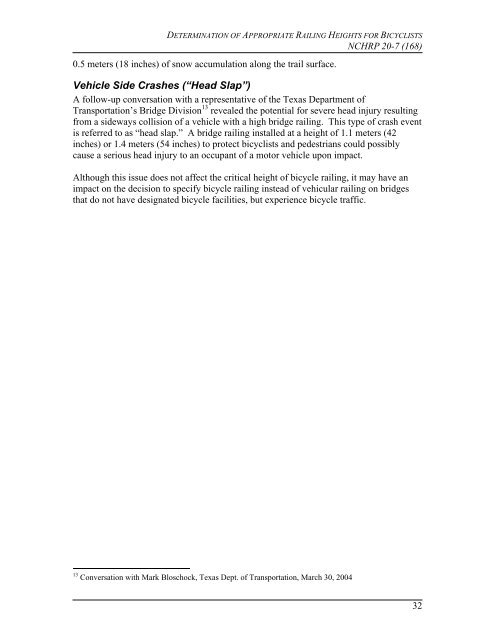Bicycle Railing Height Report - AASHTO - Subcommittee on Design
Bicycle Railing Height Report - AASHTO - Subcommittee on Design
Bicycle Railing Height Report - AASHTO - Subcommittee on Design
You also want an ePaper? Increase the reach of your titles
YUMPU automatically turns print PDFs into web optimized ePapers that Google loves.
DETERMINATION OF APPROPRIATE RAILING HEIGHTS FOR BICYCLISTS<br />
NCHRP 20-7 (168)<br />
0.5 meters (18 inches) of snow accumulati<strong>on</strong> al<strong>on</strong>g the trail surface.<br />
Vehicle Side Crashes (“Head Slap”)<br />
A follow-up c<strong>on</strong>versati<strong>on</strong> with a representative of the Texas Department of<br />
Transportati<strong>on</strong>’s Bridge Divisi<strong>on</strong> 13 revealed the potential for severe head injury resulting<br />
from a sideways collisi<strong>on</strong> of a vehicle with a high bridge railing. This type of crash event<br />
is referred to as “head slap.” A bridge railing installed at a height of 1.1 meters (42<br />
inches) or 1.4 meters (54 inches) to protect bicyclists and pedestrians could possibly<br />
cause a serious head injury to an occupant of a motor vehicle up<strong>on</strong> impact.<br />
Although this issue does not affect the critical height of bicycle railing, it may have an<br />
impact <strong>on</strong> the decisi<strong>on</strong> to specify bicycle railing instead of vehicular railing <strong>on</strong> bridges<br />
that do not have designated bicycle facilities, but experience bicycle traffic.<br />
13 C<strong>on</strong>versati<strong>on</strong> with Mark Bloschock, Texas Dept. of Transportati<strong>on</strong>, March 30, 2004<br />
32


